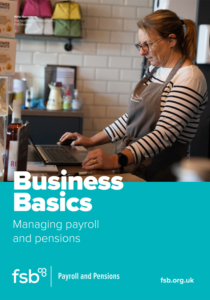
Hiring employees is an exciting step in growing your small business, but payroll can be time-consuming and confusing. There’s more to payroll than simply paying your staff. You’ll need to account for each employee’s deductions, operate PAYE and ensure you’re compliant with pension contributions.
At the Federation of Small Businesses, our payroll specialists from FSB Payroll and Pensions are here to help you get started with managing payroll as a small business, so you can get back to managing your team.
What do you need to do when you hire an employee?
Whether you’re recruiting your first employee or growing your team, there is a checklist you need to follow for every person you employ. You need to follow these steps to stay compliant with payroll.
- Register as an employer with HMRC
- Get a PAYE online login
- Set up a Pay As You Earn (PAYE) payroll scheme (a payroll provider can also do this for you)
- Set up payroll software
- Ask your employee for information to work out their tax code (A P45 or HMRC’s starter checklist)
- Request their National Insurance number
- Register your employee with HMRC using a Full Payment Submission
- Register with the Construction Industry Scheme if you’re paying subcontractors
Don’t forget, there are other responsibilities you’ll need to remember as an employer, for example, employer’s liability insurance and creating the correct documents such as employment contracts.
What is PAYE?
You need to operate PAYE in your payroll, which HMRC uses to collect income tax and National Insurance from your employees through deductions. Other deductions you may need to make include student loan repayments or pension contributions.
When do you need to pay this?
- Monthly payments: 22nd of the following tax month
- Quarterly payments: 22nd after the end of the quarter
What do you need to do?
On or before payday
- Record the employee’s pay
- Calculate any deductions like income tax and National Insurance
- Work out how much employer’s National Insurance you’ll need to pay
- Produce and distribute payslips
- Report pay and deductions in a Full Payment Submission to HMRC
Whilst you’ll have a weekly or monthly routine for payroll, there are also annual duties that you’ll need to carry out. From sending your final payroll report to updating tax codes and issuing P60s, make sure you don’t miss any tasks with our checklist for the start of the tax year.
All employers must report their PAYE information to HMRC in real time. This is known as Real Time Information (RTI). RTI means that you must report to HMRC every time you pay an employee, at the time you pay them.
What employer contributions do you need to pay?
Employers’ Class 1 National Insurance contributions, rates, and thresholds for the 2022/23 tax year can be found on the government website
The Employment Allowance lets eligible employers reduce their National Insurance liability by up to £5,000 for the 2022/23 tax year. You can learn more about eligibility and how to claim the Employment Allowance with our handy guide.
What about workplace pensions?
You have a responsibility to ensure a compliant workplace pension is in place for all eligible employees, no matter how small your team. With auto-enrolment, triennial reviews and annual duties, there’s a lot to think about – and a lot of paperwork to deal with – but you risk fines from The Pensions Regulator if your scheme isn’t compliant. Discover our top tips for keeping your workplace pensions scheme compliant.
Employing seasonal employees? Postponement allows you to delay auto enrolment of new starters or temporary staff joining you on a short-term basis. You can delay the process of assessing an employee for auto enrolment to your pension scheme for a maximum of three months.
What payroll records do you need to keep?
- Employee pay and deductions (tax, National Insurance, student loan repayments, pension contributions etc.)
- Reports and payments made to HMRC
- Employee leave and sickness absences
- Tax code notices
- Taxable expenses or benefits
- Proof you have paid correct minimum wage
What do you need to do when an employee leaves?
You need to tell HMRC when an employee leaves your business.
- Put the employee’s leaving date on their payroll record
- Make deductions as normal when you send you next Full Payment Submission
- Give the employee a P45
- You’ll also need to:
- Decide whether it’s best for your employee to work their notice period or offer payment in lieu
- Arranging cover for the employee where necessary
- Confirm their notice period
- Handle any leftover contractual holiday that has been accrued
These records are important in the event of a PAYE compliance check, as HMRC may request to see your records up to three years after the tax year they relate to.
What is a PAYE compliance check?
HMRC may carry out an inspection to make sure you’re paying the right amount of tax. If you’re selected for investigation, HMRC will typically ask to visit your business premises to review the payroll records. It’s likely to involve a review of the payroll payments made to employees.
FSB members have the support of FSB Tax Investigation Protection in the event of an HMRC enquiry. One of our specialists would be appointed to deal with the HMRC correspondence on your behalf, such as if more information or documents are requested.
Learn more about what happens during an HMRC enquiry.
Meet payroll support that’s more than just software
Business life is busy enough already. With dedicated support by your side, you can wave goodbye to endless payroll admin and spend more time running your business.


